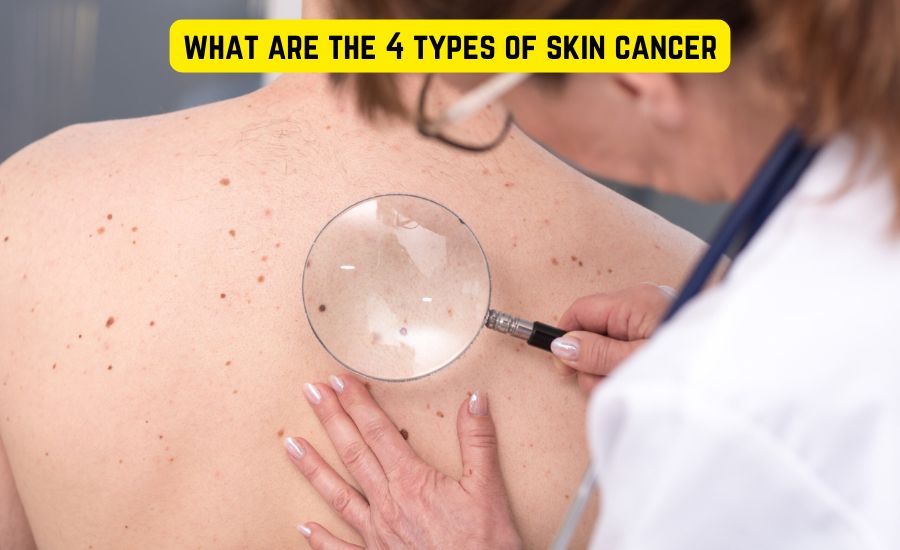What are the 4 types of skin cancer? This is a common question many people ask when they want to learn about skin health. Skin cancer happens when skin cells grow in a way that is not normal. Knowing the types of skin cancer can help you understand your body better.
There are 4 main types of skin cancer, and each type has its own features. Some are more dangerous than others, but all types need attention. In this post, we will explain each type in simple words so you can easily understand.
What Are the 4 Types of Skin Cancer? A Simple Guide
Skin cancer is a disease that happens when skin cells grow strangely. Many people wonder, “What are the 4 types of skin cancer?” Knowing these types can help you understand what to look out for. Each type of skin cancer has its own risks and signs to notice.
The first type is basal cell carcinoma (BCC), which is the most common. This type usually grows slowly and doesn’t spread much. It can look like a small bump or a shiny patch on your skin. Even though it’s not usually dangerous, it still needs treatment.
Next, there is squamous cell carcinoma (SCC). This type is more serious than BCC and can spread if it’s not treated. It often shows up as red, scaly patches or sores that don’t heal. Paying attention to changes in your skin is very important.
Why It’s Important to Know the 4 Types of Skin Cancer
Understanding the different types of skin cancer can save lives. Knowing the signs of each kind helps you take action early. Early treatment is easier and more successful than waiting too long.
Skin cancer often starts small, so it’s easy to miss. If you know what to look for, you can notice the changes in time. Learning about basal cell carcinoma, squamous cell carcinoma, melanoma, and other types helps you stay aware of your skin health.
Doctors say early detection is key. For example, treating basal cell carcinoma early can stop it from getting worse. Squamous cell carcinoma, if caught soon, is also highly treatable. Melanoma, however, can become very serious if ignored.
Finally, protecting your skin from too much sun is one of the best ways to lower your risk. Using sunscreen, wearing hats, and staying in the shade can make a big difference.
How Does Skin Cancer Happen?
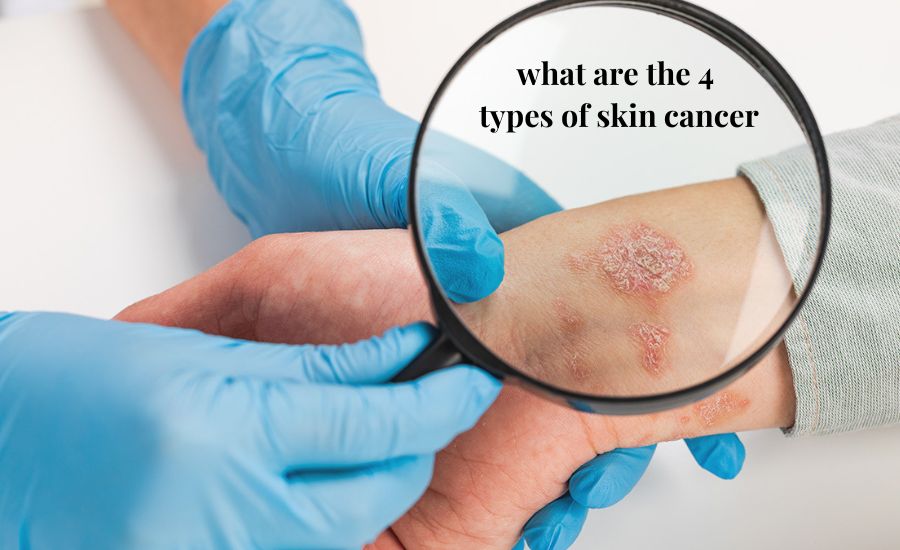
Skin cancer happens when skin cells are damaged and start growing out of control. The main cause is too much sun exposure, which harms the skin. Over time, this damage can turn into cancer.
Not all skin cancer is caused by the sun. Some types, like melanoma, can also happen because of genetics. If skin cancer runs in your family, you should be extra careful.
Even tanning beds can increase the risk of skin cancer. They use harmful UV rays, just like the sun. Avoiding these and protecting your skin is essential.
Understanding Basal Cell Carcinoma: A Common Skin Cancer
Basal cell carcinoma (BCC) is the most common type of skin cancer. It usually grows slowly and doesn’t spread to other parts of the body. This type of cancer often appears on areas exposed to the sun, like the face, neck, or arms.
You might notice tiny bumps or shiny patches on your skin. These spots can be pink, red, or even look like scars. While BCC isn’t usually life-threatening, ignoring it can cause it to grow deeper into your skin.
Early treatment is the key to managing BCC. Treatments include creams, minor surgeries, or freezing the affected area. Protecting your skin from the sun can help reduce the risk of developing this type of cancer.
What You Should Know About Squamous Cell Carcinoma
Squamous cell carcinoma (SCC) is the second most common type of skin cancer. It grows faster than BCC and can spread to other parts of the body if not treated. SCC often appears in sun-exposed areas, but it can also form in scars or wounds.
Look out for red, scaly patches or sores that don’t heal. Sometimes, it may look like a wart or a rough, crusty spot. If you notice these signs, see a doctor right away.
Doctors can treat SCC with surgery, radiation, or creams. Early detection is vital because untreated SCC can cause serious problems. Avoiding too much sun and wearing sunscreen are simple ways to prevent it.
Melanoma: The Most Dangerous Type of Skin Cancer
Melanoma is the most dangerous type of skin cancer. It can grow and spread very quickly, making early detection crucial. This type often starts as a mole that changes in size, shape, or colour.
Check your skin for moles that have uneven edges, different colours, or are more significant than usual. These could be signs of melanoma. It’s essential to watch for new spots or changes in existing moles.
If melanoma is caught early, treatments like surgery or immunotherapy can work well. However, late-stage melanoma is more challenging to treat. Protecting your skin from sunburns and avoiding tanning beds can help lower your risk.
What Is Merkel Cell Carcinoma and Why Is It Rare?
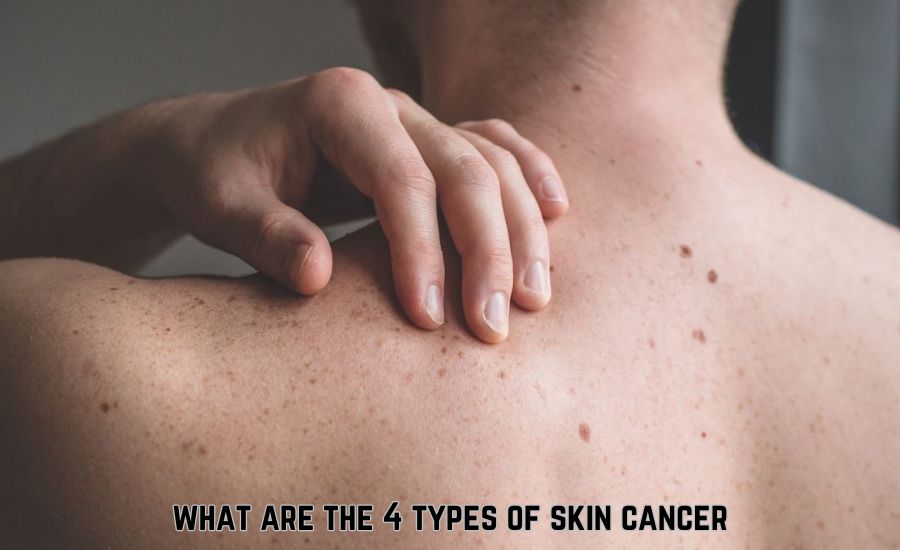
Merkel cell carcinoma (MCC) is a rare type of skin cancer. It proliferates and can spread to other parts of the body. MCC often appears as a firm, red or purple bump on your skin, usually on your face, head, or neck.
This type of cancer is more common in older adults and people with weak immune systems. Sun exposure and a history of other skin cancers can also increase the risk of MCC.
Doctors treat MCC with surgery, radiation, or chemotherapy. Because it grows so fast, early detection is critical. Regular skin checks can help catch it before it spreads.
Signs to Look for in the 4 Types of Skin Cancer
Each type of skin cancer has its own signs. Basal cell carcinoma may look like a shiny bump, while squamous cell carcinoma often appears as a scaly patch. Melanoma can be spotted as a mole that changes over time, and Merkel cell carcinoma looks like a firm, red bump.
Always check your skin for spots that don’t heal or change in colour, size, or shape. Paying attention to these changes can help you catch cancer early.
If you notice something unusual, don’t wait. Visit a doctor for a skin check. Early detection makes treatment more manageable and more effective.
What Are the Causes of Skin Cancer?
Skin cancer happens when skin cells are damaged by UV rays from the sun or tanning beds. These rays harm the DNA in your skin cells, causing them to grow abnormally.
Genetics can also play a role. If your family has a history of skin cancer, you might be at higher risk. Having a weak immune system can increase the chances, too.
Protecting your skin by avoiding too much sun exposure is key. Wearing sunscreen, staying in the shade, and covering your skin with clothing can help prevent damage.
Can You Prevent the 4 Types of Skin Cancer?
Prevention is better than cure when it comes to skin cancer. Protecting your skin from UV rays is the best way to lower your risk. Always wear sunscreen, even on cloudy days, and reapply it regularly.
Avoid tanning beds, as they can increase your risk of all types of skin cancer. Wearing protective clothing like hats and sunglasses is another smart choice.
Regular skin checks are essential. Catching changes early can prevent serious problems later. Healthy habits like these can keep your skin safe and healthy.
What Are the Treatments for Different Types of Skin Cancer?
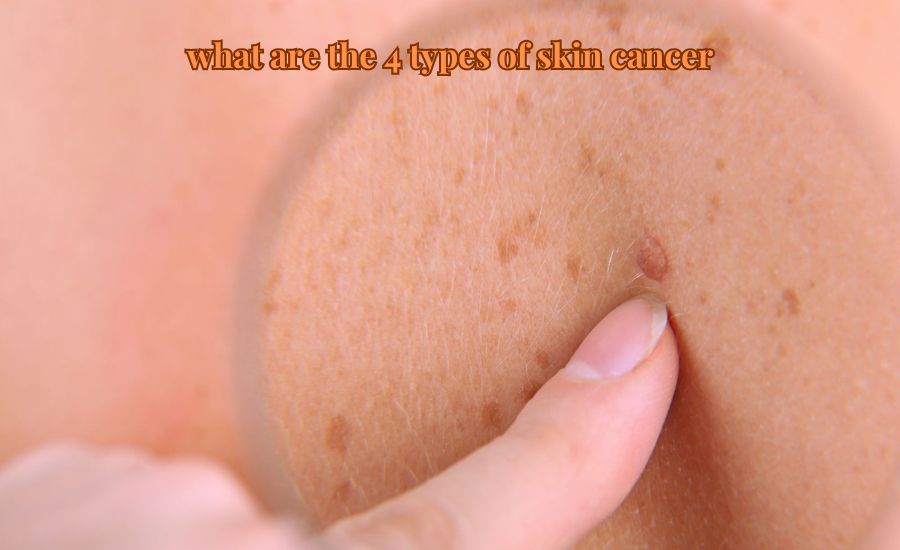
Skin cancer treatments depend on the type and stage of the cancer. Early stages often have more straightforward treatments, while advanced stages need more care. Knowing the options can help you feel prepared if you or someone you know faces this challenge.
Basal cell carcinoma (BCC) is usually treated with minor surgery. Doctors may remove the affected area thoroughly. Sometimes, creams or freezing methods are used to destroy cancer cells. This type rarely comes back if treated early.
For squamous cell carcinoma (SCC), surgery is also common. If the cancer has spread, radiation or chemotherapy may be needed. These treatments aim to stop the tumour from growing further.
Melanoma often needs more serious treatment. Surgery removes the cancer, but advanced cases might require immunotherapy or targeted therapy. These newer treatments help the immune system fight cancer cells.
How to Check Your Skin for Signs of Cancer
Checking your skin regularly is essential for catching skin cancer early. You don’t need special tools—just good lighting and a mirror can help. Knowing what to look for makes the process easier.
Start by looking at all parts of your skin, including hard-to-see areas like your back and behind your ears. Use a hand mirror if needed. Check for new spots, bumps, or sores that don’t heal.
Pay attention to moles. If they change in size, shape, or colour, it could be a warning sign. The “ABCDE rule” (Asymmetry, Border, Color, Diameter, Evolving) helps you spot suspicious moles.
Make skin checks a habit. Doing it once a month can help you notice changes early. If you find something unusual, see a doctor right away. Early detection can save your life.
What Are the 4 Types of Skin Cancer and How Are They Different?
There are 4 main types of skin cancer, each with unique features. Knowing these differences helps you understand what to watch for.
Basal cell carcinoma (BCC) is the most common and least dangerous. It grows slowly and rarely spreads. It often looks like a shiny bump or a sore that doesn’t heal.
Squamous cell carcinoma (SCC) is more serious because it can spread to other parts of the body. It may appear as a scaly patch, a red bump, or an open sore.
Melanoma is the deadliest type. It proliferates and spreads if not treated early. It often looks like a mole that changes shape or colour.
Merkel cell carcinoma is rare but aggressive. It appears as a fast-growing lump, usually on sun-exposed areas. Early detection is crucial for all types.
How Can Early Detection Help With Skin Cancer?
Catching skin cancer early makes treatment more straightforward and more successful. It can also prevent the cancer from spreading to other parts of the body. Regular skin checks and doctor visits are key.
Early detection means smaller tumours, which are easier to remove. Treatments like surgery or creams work well in the early stages. Basal and squamous cell carcinomas are often curable when found early.
Melanoma is more challenging to treat if it spreads. Checking moles for changes can help you find them before they become serious. Doctors recommend looking at your skin once a month for new or changing spots.
Protecting your skin also helps prevent cancer. Sunscreen, protective clothing, and avoiding tanning beds are good habits. Early care can make a big difference in staying healthy.
Tips to Keep Your Skin Healthy and Safe from Cancer
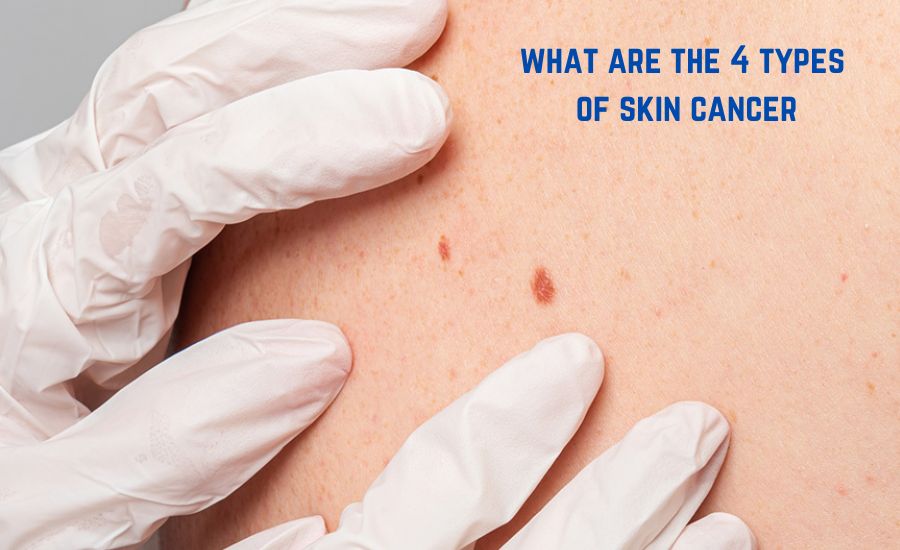
Keeping your skin safe from cancer is easy with a few good habits. Follow these tips to protect your skin and stay healthy:
- Use Sunscreen Daily: Always apply sunscreen with SPF 30 or higher before going outside. Reapply every two hours, especially if you’re swimming or sweating.
- Wear Protective Clothing: Cover your skin with hats, long sleeves, and sunglasses. These items block harmful UV rays and prevent sun damage.
- Stay in the Shade: Avoid direct sunlight between 10 a.m. and 4 p.m., when the sun is strongest. If you’re outside, find shade under trees or umbrellas.
- Avoid Tanning Beds: Tanning beds expose your skin to harmful UV rays, increasing the risk of skin cancer. Embrace your natural skin tone instead.
- Check Your Skin Regularly: Look for changes like new spots, moles, or bumps that don’t heal. Early detection can help treat problems quickly.
- Eat a Healthy Diet: Foods rich in vitamins and antioxidants, like fruits and vegetables, keep your skin healthy from the inside out.
By following these steps, you can protect your skin and reduce the risk of cancer. Healthy skin is happy skin!
Conclusion
Taking care of your skin is very important to stay safe and healthy. Knowing about the 4 types of skin cancer and how to protect yourself can make a big difference. Simple things like using sunscreen, wearing protective clothes, and checking your skin can help a lot. These small steps can keep your skin looking great and free from harm.
Remember, your skin is your body’s largest organ, and it deserves good care. If you notice any unusual spots or changes, don’t wait—talk to a doctor. Early detection can save lives. Stay mindful of your skin, enjoy the sunshine safely, and keep your skin happy and healthy every day!
Must Read: 3-recovery-tips-for-after-a-colonoscopy
FAQs
Q: What are the 4 types of skin cancer?
A: The 4 types of skin cancer are basal cell carcinoma, squamous cell carcinoma, melanoma, and Merkel cell carcinoma. Each has different signs and risks.
Q: What is the most common type of skin cancer?
A: Basal cell carcinoma is the most common type. It grows slowly and rarely spreads but still needs treatment.
Q: How can I protect my skin from skin cancer?
A: Use sunscreen, wear protective clothing, avoid tanning beds, and stay in the shade during peak sunlight hours.
Q: What does melanoma look like?
A: Melanoma often looks like a dark mole or spot with uneven edges, changing color or size over time.
Q: Can skin cancer be cured?
A: Many skin cancers, like basal cell carcinoma, can be cured if found early. Advanced cases may need more treatments.
Q: How often should I check my skin for changes?
A: Check your skin once a month for new or changing spots, bumps, or moles.
Q: Who is at higher risk for skin cancer?
A: People with fair skin, a family history of skin cancer, or too much sun exposure are at higher risk.
